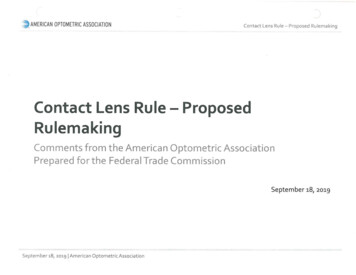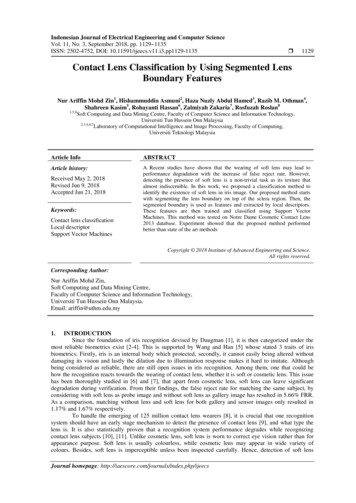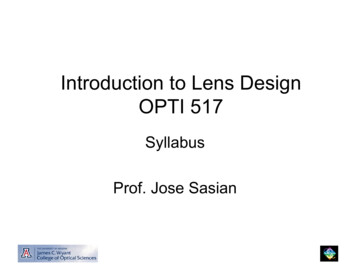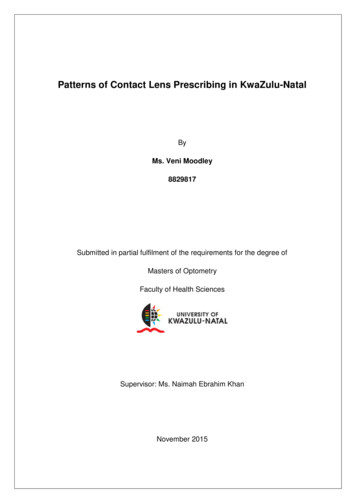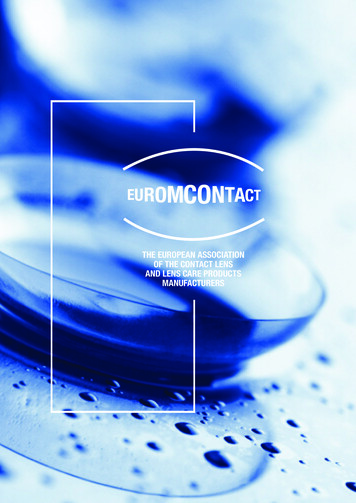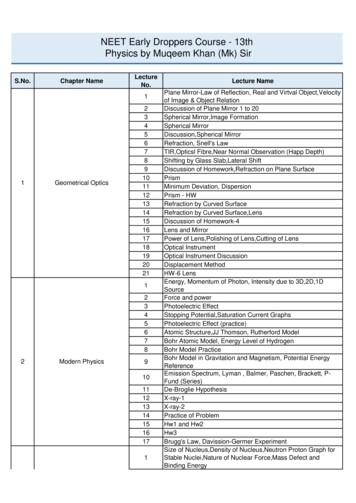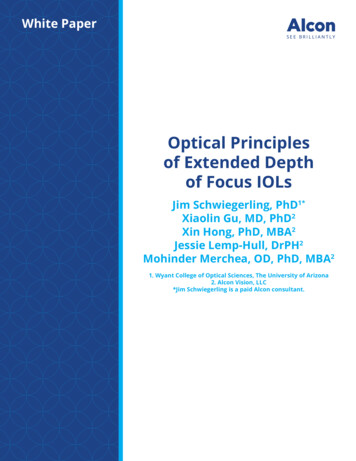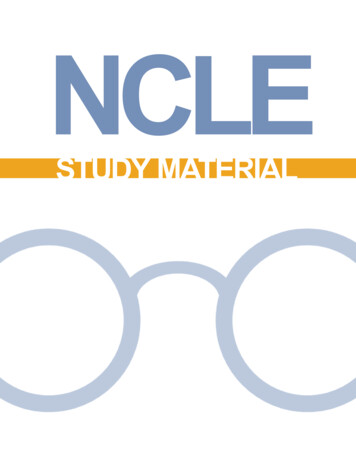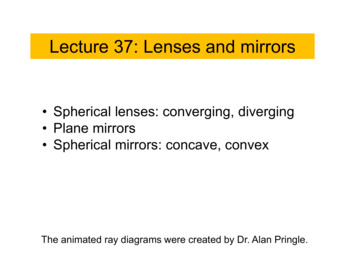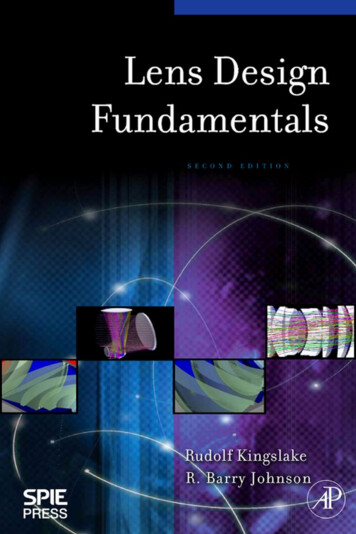
Transcription
Lens Design FundamentalsSecond EditionRUDOLF KINGSLAKER. BARRY JOHNSON
Academic Press is an imprint of Elsevier30 Corporate Drive, Suite 400Burlington, MA 01803, USAThe Boulevard, Langford LaneKidlington, Oxford, OX5 1 GB, UK#2010 Elsevier Inc. All rights reserved.Co-published by SPIEP.O. Box 10Bellingham, Washington 98227-0010 USATel.: þ1 360-676-3290 / Fax: þ1 360-647-1445Email: Books@SPIE.orgSPIE ISBN: 9780819479396SPIE Vol: PM195No part of this publication may be reproduced or transmitted in any form or by any means,electronic or mechanical, including photocopying, recording, or any information storage andretrieval system, without permission in writing from the publisher. Details on how to seek permission, further information about the Publisher’s permissions policies and our arrangements withorganizations such as the Copyright Clearance Center and the Copyright Licensing Agency, canbe found at our website: www.elsevier.com/permissions.This book and the individual contributions contained in it are protected under copyright bythe Publisher (other than as may be noted herein).NoticesKnowledge and best practice in this field are constantly changing. As new research and experiencebroaden our understanding, changes in research methods, professional practices, or medicaltreatment may become necessary.Practitioners and researchers must always rely on their own experience and knowledge inevaluating and using any information, methods, compounds, or experiments described herein. Inusing such information or methods they should be mindful of their own safety and the safety ofothers, including parties for whom they have a professional responsibility.To the fullest extent of the law, neither the Publisher nor the authors, contributors, or editors,assume any liability for any injury and/or damage to persons or property as a matter of productsliability, negligence or otherwise, or from any use or operation of any methods, products,instructions, or ideas contained in the material herein.Library of Congress Cataloging-in-Publication DataApplication submitted.ISBN: 978-0-12-374301-5British Library Cataloguing-in-Publication DataA catalogue record for this book is available from the British Library.For information on all Academic Press publicationsvisit our Web site at www.elsevierdirect.comPrinted in the United States09 10 11 12 131098765 4321
To my dearest wife Marianne Faircloth Johnsonand our remarkable son Rutherford Barry Johnsonfor their gentle encouragement and support.In memory of my parents,J. Ralph and Sara F. Johnson,for their enduring tolerance of my often trying inquisitiveness.AndIn memory of Rudolf Kingslake (1903–2003),who taught me to appreciate the beauty in well-designed lenses.
ContentsPreface to the Second EditionPreface to the First EditionA Special Tribute to Rudolf KingslakeChapter 1The Work of the Lens Designer1.11.21.31.41.5Chapter 2Chapter 3Chapter 4Relations Between Designer and FactoryThe Design ProcedureOptical MaterialsInterpolation of Refractive IndicesLens Types to be Consideredixxiiixv128111620Meridional Ray uctionGraphical Ray TracingTrigonometrical Ray Tracing at a Spherical SurfaceSome Useful RelationsCemented Doublet ObjectiveRay Tracing at a Tilted SurfaceRay Tracing at an Aspheric SurfaceParaxial Rays and First-Order Optics513.13.23.33.43.55263677887Tracing a Paraxial RayMagnification and the Lagrange TheoremThe Gaussian Optics of a Lens SystemFirst-Order Layout of an Optical SystemThin-Lens Layout of Zoom SystemsAberration trical Optical SystemsAberration Determination Using Ray Trace DataCalculation of Seidel Aberration Coefficients
ContentsChapter 5vChromatic ter 6Chapter 81451491521561621631736.16.26.36.4176194197Surface Contribution FormulasZonal Spherical AberrationPrimary Spherical AberrationThe Image Displacement Causedby a Planoparallel PlateSpherical Aberration Tolerances204206Design of a Spherically Corrected Achromat2097.17.27.37.4209211216220The Four-Ray MethodA Thin-Lens PredesignCorrection of Zonal Spherical AberrationDesign of an Apochromatic ObjectiveOblique Beams8.18.28.38.48.5Chapter 9143Spherical Aberration6.5Chapter 7IntroductionSpherochromatism of a Cemented DoubletContribution of a Single Surface to the PrimaryChromatic AberrationContribution of a Thin Element in a Systemto the Paraxial Chromatic AberrationParaxial Secondary SpectrumPredesign of a Thin Three-Lens ApochromatThe Separated Thin-Lens Achromat (Dialyte)Chromatic Aberration TolerancesChromatic Aberration at Finite AperturePassage of an Oblique Beam througha Spherical SurfaceTracing Oblique Meridional RaysTracing a Skew RayGraphical Representation of Skew-RayAberrationsRay Distribution from a Single Zoneof a Lens227227234238243252Coma and the Sine Condition2559.19.2255256The Optical Sine TheoremThe Abbe Sine Condition
Contentsvi9.39.4Chapter 10Offense Against the Sine ConditionIllustration of Comatic ErrorDesign of Aplanatic hapter 11Chapter 12Chapter 14Broken-Contact TypeParallel Air-Space TypeAn Aplanatic Cemented DoubletA Triple Cemented AplanatAn Aplanat with a Buried AchromatizingSurfaceThe Matching Principle280283The Oblique 6306313316318Astigmatism and the Coddington EquationsThe Petzval TheoremIllustration of Astigmatic ErrorDistortionLateral ColorThe Symmetrical PrincipleComputation of the Seidel AberrationsLenses in Which Stop Position Is a Degreeof Freedom323The H0 – L PlotSimple Landscape LensesA Periscopic LensAchromatic Landscape LensesAchromatic Double Lenses32332533133433912.112.212.312.412.5Chapter 13258266Symmetrical Double Anastigmats with Fixed Stop35113.113.213.313.413.5351355363369The Design of a Dagor LensThe Design of an Air-Spaced Dialyte LensA Double-Gauss–Type LensDouble-Gauss Lens with Cemented TripletsDouble-Gauss Lens with Air-spaced NegativeDoublets373Unsymmetrical Photographic Objectives37914.114.214.3379388397The Petzval Portrait LensThe Design of a Telephoto LensLenses to Change Magnification
Contentsvii14.414.514.6Chapter 15Chapter 16Chapter 17AppendixIndexThe Protar LensDesign of a Tessar LensThe Cooke Triplet Lens400409419Mirror and Catadioptric 471482497Comparison of Mirrors and LensesRay Tracing a Mirror SystemSingle-Mirror SystemsSingle-Mirror Catadioptric SystemsTwo-Mirror SystemsMultiple-Mirror Zoom SystemsSummaryEyepiece Design50116.116.216.3502506510Design of a Military-Type EyepieceDesign of an Erfle EyepieceDesign of a Galilean ViewfinderAutomatic Lens Improvement 22523524525525Finding a Lens Design SolutionOptimization PrinciplesWeights and Balancing AberrationsControl of Boundary ConditionsTolerancesProgram LimitationsLens Design Computing DevelopmentPrograms and Books Useful for AutomaticLens DesignA Selected Bibliography of Writingsby Rudolf Kingslake529535537
This page intentionally left blank
Preface to the Second EditionInasmuch as the first edition of this book could be regarded as an extensionand modernization of Professor Alexander Eugen Conrady’s Applied Optics andOptical Design, this second edition can be viewed as a further extension andmodernization of Conrady’s 80-year-old treatise.1 As was stated in the prefaceto the first edition, referring to Conrady’s book, “This was the first practicaltext to be written in English for serious students of lens design, and it receiveda worldwide welcome.” Until then, optical design was generally in a disorganized state and design procedures were often considered rather mysterious bymany.In 1917, the Department of Technical Optics at the Imperial College of Science and Technology in London was founded. Conrady was invited to the principal teaching position as a result of his two decades of success in designing newtypes of telescopic, microscopic, and photographic lens systems, and for hiswork during WWI in designing most of the new forms of submarine periscopesand some other military instruments. Arguably, his greatest achievement was toestablish systematic and instructive methods for teaching practical opticaldesign techniques to students and practitioners alike. Without question,Conrady is the father of practical lens design.2,3Rudolf Kingslake (1903–2003) earned an MSc. degree under Professor Conrady, earning himself a commendable reputation while a student and during hisearly career. Soon after The Institute of Optics was founded in 1929 at theUniversity of Rochester in New York, Kingslake was appointed an AssistantProfessor of Geometrical Optics and Optical Design. His contributions to thefields of lens design and optical engineering are legendary. Most lens designerscan trace the roots of their education back to Kingslake. Following in Conrady’sfootsteps, Kingslake is certainly the father of lens design in the United States.1A. E. Conrady, Applied Optics and Optical Design, Part I, Oxford Univ. Press, London (1929);also Dover, New York (1957); Part II, Dover, New York (1960).2R. Kingslake and H. G. Kingslake, “Alexander Eugen Conrady, 1866–1944,” Applied Optics,5(1):176–178 (1966).3Conrady commented that he limited the content of his book to what the great English electrical engineer Silvamus P. Thomson called “real optics” and excluded purely mathematical acrobatics, which Thomson called “examination optics” (see Ref. 1).
xPreface to the Second EditionKingslake published numerous technical papers, was awarded an array ofpatents, wrote a variety of books, and taught classes in lens design for nearlyhalf a century.4 Collectively these have had a major impact on practicing lensdesigners and optical engineers. Perhaps his most important contribution wasthe first edition of Lens Design Fundamentals in 1978, followed in 1983 byOptical System Design. In the years since the first edition was published,spectacular advances in optical technology have occurred.The pervasive infusion of optics into seemingly all areas of our lives, perhapsonly dreams in 1978, has resulted in significant developments in optical theory,software, and manufacturing technology. As a consequence, a revised andexpanded edition has been produced primarily to address the needs of the lensdesign beginner, just as was the first edition. Nevertheless, those practitionersdesiring to obtain an orderly background in the subject should find this secondedition an appropriate book to study because it contains about 50 percent morepages and figures than the first edition by Kingslake.Revising this book without the participation of its first author presentedsomewhat of a challenge. The issues of what to retain, change, add, and so on,were given significant consideration. Having taught a number of classes in lensdesign and optical engineering myself during the past 35 years, often using LensDesign Fundamentals as the textbook, the importance of the student masteringthe fundamental elements of practical lens design, rather than simply relying ona lens design program, cannot be overemphasized.Notation and sign conventions used in lens design have varied over the years,but currently almost everyone is using a right-handed Cartesian coordinate system. In preparing this edition, figures, tables, and equations were changed froma left-handed Cartesian coordinate system with the reversed slope angles usedby Conrady and Kingslake into a right-handed Cartesian coordinate system.The student may wonder why different coordinate systems have been used overthe years. Minimization of manual computation effort is the answer. Elimination of as many minus signs as possible was the objective to both increasecomputational speed and reduce errors. Today, manual ray tracing is rarelydone, so it makes good sense to use a right-handed Cartesian coordinate system,which also makes interfacing with other modeling, CAD, and manufacturingprograms easier.Since the first edition, a number of books have been published on the topic ofaberration theory. Some authors of these books tend to suggest that wavefrontaberrations are preferable to longitudinal or transverse ray aberrations. In reality, these aberration forms are directly related (see Chapter 4). The approachused by Conrady and Kingslake to study aberrations was to use real ray errors,4A selected bibliography of the writings of Rudolf Kingslake is provided in the Appendix ofthis book.
Preface to the Second Editionxioptical path differences (OPD), and (D d) for chromatic correction, in contrast to wavefront aberrations expressed by a polynomial or Zernike expansion.In this second edition, the same approach is continued for various reasons, butprimarily because experience has shown that beginning lens design studentsmore intuitively comprehend ray aberrations.The content here has been revised and expanded to reflect the generalchanges that have occurred since the first edition. Chapter titles remain the sameexcept that a new overview chapter about aberrations has been added. All thechapters have been revised to some extent, often including new examples, significantly more literature references, and additional subject content. The finalchapter, discussing automatic lens design, was completely rewritten. Althoughthe types of optical systems had been limited to rotationally symmetric systems,the chapter on mirrors and catadioptric systems was expanded to include a variety of newer systems with some having eccentric pupils. Some material fromOptical System Design has been incorporated without attribution. The readerwill notice that trigonometric ray tracing is still discussed in this edition. Thereason is that many concepts are profitably discussed using ray trace information. These discussions and examples contain the ray trace data for studentsto consider without having to generate it themselves.The lack of explanations about how to use any particular computer-basedlens design program was intentional because such a program is not requiredto learn the fundamentals; however, the student will find significant benefit inexploring many of the examples using a lens design program to replicate whatis shown and perhaps to improve on or change the design. Much can be learnedfrom such experimentation by the student. Following the philosophy of Conrady and Kingslake, this book contains essentially no problems for the studentto work since there are numerous fully worked examples of the principles forstudents to follow and expand on themselves. Instructors can develop theirown problems to supplement their teaching style, computational resources,and course objectives.Lens design is based not only on scientific principles, but also on the talent ofthe designer. Shannon appropriately titled his book The Art and Science of Optical Design.5 A new feature in this edition is the occasional insertion of aDesigner Note; these provide the student with additional relevant informationthat is somewhat out of the flow of the basic text. Reasonable effort has beengiven to making this edition have improved clarity and to being morecomprehensive.Although many new technologies have become available for lens designers toemploy, such as diffractive surfaces, free-form surfaces, systems without5Robert R. Shannon, The Art and Science of Optical Design, Cambridge University Press,Cambridge (1997).
xiiPreface to the Second Editionsymmetry, holographic lenses, polarization, Fresnel surfaces, gradient indexlenses, birefringent materials, superconic surfaces, Zernike surfaces, and so on,they intentionally have not been included. Once students and self-taught practitioners have mastered the fundamentals taught in this edition, they should beable to quickly develop the ability to use these other technologies, surfaces,and materials through study of the literature and/or the manual for the lensdesign program of their choice.AcknowledgmentsIn 1968, it was my good fortune to meet Professor Kingslake when he gave aseries of lectures on lens design at Texas Instruments and, with his encouragement, I soon went to The Institute of Optics for graduate studies. Not onlywas he my teacher, but he also became a good friend and mentor for decades.Without question, his teaching style and willingness to share his extraordinaryknowledge positively impacted my career in optical design as it did for the multitude of others who had the occasion to study under Kingslake. I am humbledand appreciative to have had the opportunity to prepare this second edition ofhis book and hope that he would have approved of my revisions.My sincere gratitude is given to Dr. Jean Michel Taguenang and Mr. AllenMann whose careful reading of, and comments about, the manuscript resultedin a better book; to Professor Brian Thompson and Mr. Martin Scott forproviding access to early documents containing Kingslake’s work; and toThompson for writing “A Special Tribute to Rudolf Kingslake.” I acknowledge,with thanks, Professor Jose Sasian, who suggested that I undertake the projectof preparing this second edition, and Dr. William Swantner for many constructive discussions on practical optical design. The tireless efforts and professionalism of Marilyn E. Rash, an Elsevier Inc. Project Manager, during the editing,proofreading, and production stages of this book are sincerely appreciated.R. Barry JohnsonHuntsville, Alabama
Preface to the First EditionThis book can be regarded as an extension and modernization of Conrady’s50-year-old treatise, Applied Optics and Optical Design, Part I of which was published in 1929.* This was the first practical text to be written in English for serious students of lens design, and it received a worldwide welcome.It is obvious, of course, that in these days of rapid progress any scientificbook written before 1929 is likely to be out of date in 1977. In the early yearsof this century all lens calculations were performed slowly and laboriously bymeans of logarithms, the tracing of one ray through one surface taking at leastfive minutes. Conrady, therefore, spent much time and thought on the development of ways by which a maximum of information could be extracted from thetracing of a very few rays.Today, when this can be performed in a matter of seconds or less on a small computer—or even on a programmable pocket calculator—the need for Conrady’ssomewhat complicated formulas has passed, but they remain valid and can beused profitably by any designer who takes the trouble to become familiar withthem. In the same way, the third-order or Seidel aberrations have lost muchof their importance in lens design. Even so, in some instances such as the predesign of a triplet photographic objective, third-order calculations still save anenormous amount of time.Since Conrady’s day, a great deal of new information has appeared, and newprocedures have been developed, so that a successor to Conrady’s book is seriously overdue. Many young optical engineers today are designing lenses withthe aid of an optimization program on a large computer, but they have littleappreciation of the how and why of lens behavior, particularly as these computer programs tend to ignore many of the classical lens types that have beenfound satisfactory for almost a century. Anyone who has had the experienceof designing lenses by hand is able to make much better use of an optimizationprogram than someone who has just entered the field, even though that newcomer may have an excellent academic background and be an expert in computer operation.For this reason an up-to-date text dealing with the classical processes of lensdesign will always be of value. The best that a computer can do is to optimize*A. E. Conrady, Applied Optics and Optical Design, Part I, Oxford University Press, London(1929); also Dover (1957); Part II, Dover, New York (1960).
xivPreface to the First Editionthe system given to it, so the more understanding and competent the designer,the better the starting system he will be able to give the computer. A perceptivepreliminary study of a system will often indicate how many solutions exist intheory and which one is likely to yield the best final form.A large part of this book is devoted to a study of possible design proceduresfor various types of lens or mirror systems, with fully worked examples of each.The reader is urged to follow the logic of these examples and be sure that heunderstands what is happening, noticing particularly how each available degreeof freedom is used to control one aberration. Not every type of lens has beenconsidered, of course, but the design techniques illustrated here can be readilyapplied to the design of other, more complex systems. It is assumed that thereader has access to a small computer to help with the ray tracing; otherwise,he may find the computations so time-consuming that he is liable to lose trackof what he is trying to accomplish.Conrady’s notation and sign conventions have been retained, except that thesigns of the aberrations have been reversed in accordance with current practice.Frequent references to Conrady’s book have been given in footnotes as “Conrady, p. . . .”; and as the derivations of many important formulas have beengiven by Conrady and others, it has been considered unnecessary to repeat themhere. In the last chapter a few notes have been added (with the help of DonaldFeder) on the structure of an optimization program. This information is forthose who may be curious to know what must go into such a program andhow the data are handled.This book is the fruit of years of study of Conrady’s unique teaching at theImperial College in London, of 30 years of experience as Director of OpticalDesign at the Eastman Kodak Company, and of almost 45 years of teachinglens design in The Institute of Optics at the University of Rochester—all of ita most rewarding and never-ending education for me, and hopefully also formy students.Rudolf Kingslake
A Special Tribute to RudolfKingslakeRudolf Kingslake’s very first paper, written when a student at Imperial College London, was coauthored by L. C. Martin, a faculty member. The paper,“The Measurement of Chromatic Aberration on the Hilger Lens Testing Interferometer,” was received 14 February 1924 and read and discussed 13 March1924. Immediately following it was a paper by Miss H. G. Conrady, listed asa research scholar since she had already graduated in 1923. Miss Conrady’spaper was entitled “Study and Significance of the Foucault Knife-Edge TestWhen Applied to Refracting Systems” (received 21 February 1924; read anddiscussed 13 March 1924).The formal degree program in optics at Imperial College was founded inthe summer of 1917 and entered its first class in 1920. Hilda Conrady was amember of that class. Her father was A. E. Conrady, who had been appointeda Professor of Optical Design. Professor Conrady’s work and publications weredefinitive in the literature and in the teaching of optical design. In 1991,Hilda wrote a fine article in Optics and Photonics News describing “The FirstInstitute of Optics in the World.”Hilda and Rudolf became lifetime partners when they married on September14, 1929, soon before they left England because Rudolf had been appointed asthe first member in the newly formed Institute of Applied Optics at the University of Rochester in New York. It is interesting to note that for the academicyear 1936–1937, L. C. Martin, on the faculty of the Technical Optics Department at Imperial College London, and Rudolf Kingslake exchanged facultypositions. With Rudolf’s usual sense of humor, he commented that “Martinand I exchanged jobs, houses and cars . . . but not wives.”With the publication of this new edition of Lens Design Fundamentals, whichoriginally appeared in 1978, Kingslake’s published works cover a period of86 years! His last major new publication was The Photographic ManufacturingCompanies of Rochester, NewYork, published by The International Museumof Photography at the George Eastman House in 1997; so even using this datapoint his publications covered 73 years! We should also note that his extensiveteaching record extended well into his 80s and touched thousands of students.His “Summer School” courses were indeed legendary.
xviA Special Tribute to Rudolf KingslakeThe Early YearsRudolf Kingslake’s interest in optics started in his school days; he wroteabout his “entrance into optics” and said, “father had a camera handbookissued by Beck that contained many diagrams of lens sections, which got mewondering why camera lenses had four or six even eight elements?” This interestcontinued and he noted, “so when I found out that lens design was taught atImperial College in South Kensington, I was determined to go there. The collegefees were not too expensive and father soon agreed to my plan.” Thus Rudolfentered the program in 1921, graduated in 1924, continued on into graduateschool with a two-year fellowship, and earned his M.Sc. degree in 1926. Andso, a very distinguished career was launched.His graduate work at Imperial College was very productive, and a number ofsignificant papers were published including works such as “A New Type ofNephelometer,” “The Interferometer Patterns due to Primary Aberrations,”“Recent Developments of the Hartmann Test to the Measurement of ObliqueAberrations,” “The Analysis of an Interferogram,” “Increased Resolving Powerin the Presence of Spherical Aberration,” and “An Experimental Study of theBest Minimum Wavelength for Visual Achromatism.”After graduation Rudolf was appointed to a position at Sir Howard GrubbParsons and Co. in Newcastle-upon-Tyne as an optical designer. His notessay, “designed Hartmann Plate, measuring microscopic and readers for Edinburgh 30-inch Reflector. Took many photographs, translated German papers,Canberra 18-inch Coelostat device, Mica tests, etc.” In June 1928, he publisheda paper in Nature entitled “18-inch Coelostat for Canberra Observatory.”Apparently Parsons didn’t have enough work for him to do, so he acceptedan appointment with International Standard Electric Company in Hendon,North London. In Hendon he “worked on speech quality over telephone linesand made lab measurements of impedance using Owen’s bridge at various frequencies from 50 to 800 (cps). This experience was good for me as it gave mea glance at the business of electronics, designing telephones. I was paid weekly,so gave them a week’s notice when I went to America.”The Institute of Applied OpticsOnce in the Institute, Kingslake quickly developed the necessary courses andlaboratory work in the Eastman Building on the Prince Street Campus. Dr. A.Maurice Taylor, also from England, joined the Institute with responsibility forphysical optics. The permanent home was the fourth floor of the newly constructed Bausch and Lomb Hall on the River Campus. Despite a heavy teachingand planning load, Rudolf managed to produce a number of significant publications for major journals. These included “A New Bench for Testing
A Special Tribute to Rudolf KingslakexviiPhotographic Lenses,” which became the standard in the United States. A jointpaper with A. B. Simmons, who was an M.S. graduate student in optics,reported on “A Method of Projecting Star Images Having Coma and Astigmatism.” Then followed “The Development of the Photographic Objective”and “The Measurement of the Aberrations of a Microscope Objective.”The final paper during that period (1929–1937) was a joint paper with HildaKingslake writing under her maiden name of H. G. Conrady entitled “A Refractometer for the Near Infrared”; she was working as an independent researcher.Rudolf reports that “in this joint paper the design of the refractometer wasmine. Miss Conrady assisted with the assembly, adjustment and calibrationand made many of the measurements on glass prisms.”The Kodak YearsEven though Rudolf moved in 1937 to Eastman Kodak at the request ofDr. Mees, Kodak’s Director of Research, a very important arrangement wasmade for Kingslake to continue to teach on a half-time basis—a position thathe held long after his retirement. His last Summer School in Optical Designwas held in his 90th year.Although the work at Kodak was often proprietary (and even classified during the war years), he was able to publish a continual stream of importantpapers in a wide range of professional refereed journals associated with majorscientific and engineering societies. At the time of his move to Kodak, Rudolfcommented that his “industrial experience had been lamentably brief—thatmore than anything else, he needed experience in industry for greater competence in teaching an applied subject.” He was correct of course. In 1939, theInstitute of Applied Optics had a slight name change to The Institute of Optics.Once Kingslake joined Kodak, he quickly made significant contributions tothe design and evaluation of photographic lenses for both still photographyand motion picture equipment. Topics included wide-aperture photographicobjectives, resolution testing on 16-mm projection lenses, lenses for aerial photography, new optical glasses, zoom lenses, and much more (see the Appendixfor specifics).Some of the summary articles give an excellent perspective of the state of theart and its impact. His paper “The Contributions of Optics to Modern Technology and a Buoyant Economy” is a good example of the results of his exposureto the industrial world. In a joint paper, “Optical Design at Kodak,” with twomembers of his team, he summarized his work at Kodak. Finally in 1982 heproduced “My Fifty Years of Lens Design.” What a good summary!
xviiiA Special Tribute to Rudolf KingslakeBooksKingslake had an impact on the discipline of optical science and engineeringthrough his writings in a number of texts and contributions he made to varioushandbooks. His first single-au
patents, wrote a variety of books, and taught classes in lens design for nearly half a century.4 Collectively these have had a major impact on practicing lens designers and optical engineers. Perhaps his most important contribution was the first edition of Lens Design Fundamentals in 1978, followed in 1983 by Optical System Design.
